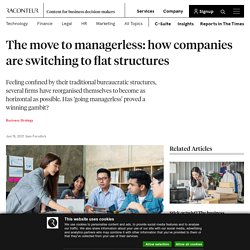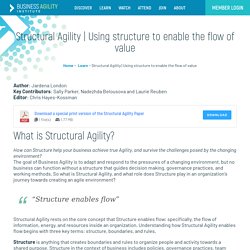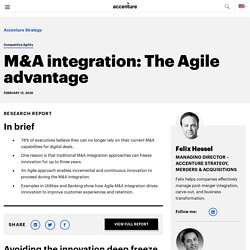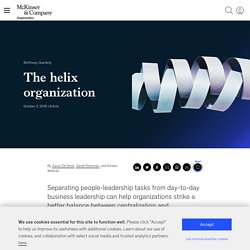

Future-proofing the organization the ‘helix’ way. Balancing flexibility and stability is the goal of any organizational structure.

In fast-changing industries, flexibility supports the mastery of technological shifts while stability provides the much-needed efficiency to scale them up. Yet, too much flexibility breeds inefficiency or even disorder. And too much stability invites inertia and bureaucracy. Locating the sweet spot is elusive. UnFIX - The Versatile Organization Model. It is time for an alternative to SAFe, LeSS, Holacracy, Management 3.0, the Spotify model, and matrix organizations.

We need something that takes flexibility to a new level, and that embraces hybrid working as the new normal. Here is my suggestion. I call it unFIX. How companies are switching to flat structures. You’ve probably spent most of your career working in hierarchical organisations, where senior managers make all the strategic decisions and tasks are delegated down the chain of command.

This method of structuring an enterprise has been the standard for generations, but that hasn’t stopped firms from deviating greatly from it in search of a better way. Networked, Scaled, and Agile: A Design Strategy for Complex Organizations (3 March 2021) by Amy Kates, Greg Kesler, Michele DiMartino, Michele and Julie Sweet. Evolution Towards TEAL Organization and the Role of Leadership in Supporting the Journey. Il n'y a pas de chef dans la firme d'ingénierie numérique Nagarro. «Il faut de la discipline pour faire de cette vision non hiérarchique une réalité», dit Manas Fuloria, PDG de Nagarro.

The Benefits of Cross-Function Team Collaboration. Global crises like the current pandemic are so complex that they can only be tackled when teams across disciplinary and organizational boundaries work together.

Break down silos at all costs. Structural Agility - Using structure to enable the flow of value. Author: Jardena London Key Contributors: Sally Parker, Nadezhda Belousova and Laurie Reuben Editor: Chris Hayes-Kossman How can Structure help your business achieve true Agility, and survive the challenges posed by the changing environment?

The goal of Business Agility is to adapt and respond to the pressures of a changing environment, but no business can function without a structure that guides decision making, governance practices, and working methods. So what is Structural Agility, and what role does Structure play in an organization’s journey towards creating an agile environment? “Structure enables flow” M&A integration: The Agile advantage. Avoiding the innovation deep freeze Historically, the focus of many M&A deals has been on growing market share and cost advantages.

For these types of deals, a traditional approach to M&A integration makes sense. Leaders start by planning and determining the integration milestones they’ll need to reach. Zappos has quietly backed away from holacracy From our Obsession The people and companies embracing new paradigms.

Six years ago, Amazon-owned Zappos began upending its traditional management structure. In lieu of a typical corporate structure, with power concentrated at the top, the online shoe retailer would adopt a decentralized system with “no job titles, no managers, no hierarchy.” CEO Tony Hsieh was originally inspired by the idea of creating a city-like environment without central planning. 2020 M&A Trends Report. Between October 10th and October 24th, 2019, a Deloitte survey conducted by OnResearch, a market research firm, polled precisely 1,000 executives - 750 at US-headquartered corporations and 250 at domestic - based private equity firms-to gauge their expectations for M&A activity in the upcoming 12 months as well as their experiences with recent transactions.

All participants in the survey work either for private or public companies with revenues in excess of $10 million, or private equity firms. The participants hold senior ranks (at least director level at the corporations). More than half of all respondents sit in the C-suite. Organizing for Innovation: Stay Ahead of Disruptive Forces. Top management team time horizon blending and organizational ambidexterity (2019) The helix organization. The CEO of a major global business, deeply frustrated, took time out recently as a large company-wide reorganization was stumbling toward its conclusion.

Hard as he and his top team had tried, he told us, attempts to make collaboration and empowerment an enterprise-wide reality were foundering. Although he had been determined to ensure resources were reallocated across the group more dynamically, people and money remained doggedly stuck in slightly revamped silos. Tensions between the group’s central functions—such as finance, HR, and IT—and the group’s decentralized businesses were continuing to rumble. As he gazed at a new organization chart on his laptop, he scratched his head while trying to make sense of the complex collection of solid- and dotted-line reporting relationships floating across the screen. The CEO in question is actually a composite of several with whom we’ve had different versions of this same conversation. Ambidexterity Continuum. Teal organizations, step by step.
Let's explore participatory management. Yves Morieux : « Les entreprises adoptent des organisations de moins en moins efficaces » Hierarchy vs flat structure: does either system really work? Going Horizontal: Creating a Non-Hierarchical Organization, One Practice at a Time (2018) by Samantha Slade. Holacracy, une règle du jeu pour jouer la partie différemment. Parlons Sport, c’est d’actualité :) Parce qu’une image vaut parfois mieux que de longs discours, laissez-moi vous présenter 2 équipes. 2 équipes, une seule règle comme différence.
L’équipe A Dans l’équipe A, des joueurs qui jouent les yeux bandés. Au bord du terrain, des assistants pour les guider, et dans la tribune le coach. Depuis toujours, on joue la partie ainsi. Dans l’équipe A, on recrute les joueurs pour leurs qualités techniques sur les postes à pourvoir, les assistants sur leur capacité à obtenir les meilleurs résultats pour satisfaire le projet du coach : gagner la partie (et renforcer sa légitimité à être le coach). Aussi, dans cette équipe, la plupart des joueurs rêvent de devenir assistant et parmi les assistants, certains se verraient bien en coach.
Dans ce système de jeu, le jeu est globalement assez lent et imprécis. L’équipe B Dans l’équipe B, chaque joueur y voit parfaitement. Dans cette équipe, chaque joueur sait pourquoi il est là. Holacracy est cette règle du jeu. Holacracy – A complete system for self-organization. How to Set Your Company Apart in a Tech-Driven World. Designing Organizations That Are Built to Change. Many executives talk about the need for greater flexibility and adaptability from their companies. But the truth is that most businesses have organized themselves in ways that inherently discourage change. A new opportunity for business process redesign.
Within the nine practices, we’ve identified important and useful sub-practices (and even sub-sub-practices) to consider; they can be found in Exhibit B (in the appendix) and will be discussed in greater detail in Part 2 of this series.11 While these practices and sub-practices aren’t intended to be the comprehensive final word on accelerating performance improvement, based on the work we’ve done, they represent a robust tradecraft for getting better faster. They may go much deeper, and they are likely to evolve as people use them and adapt them to harness evolving technological tools. Interestingly, the practices that can unlock the potential of frontline workgroups as engines of acceleration for performance are also the ones that harness the uniquely human traits and capabilities: empathy, creativity, imagination, and divergent thinking. What we learned What are the obstacles? Company organization in the age of urgency. To compete at the speed of digital, you need to unleash your strategy, your structure, and your people.
Congratulations! Your organization is performing at or near the top of its game, or it has been in the recent past. Perhaps even better, you have a strategy to improve in the near future. Now for the bad news: the good news won’t last. It can’t—at least without the right kind of organization. Ambidextrie organisationnelle et structure de la firme. A new opportunity for business process redesign.